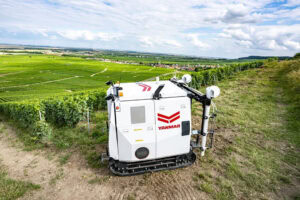Agricultural robots market worth $ 11.9 billion by 2026

According to a research report published by MarketsandMarkets, the global agricultural robots market is expected to grow from USD 4.9 billion in 2021 to USD 11.9 billion by 2026, at a compound annual growth rate (CAGR) of 19.3%.
The agricultural robots market is developing rapidly, according to the market research report “Agricultural Robots Market by Type (Milking Robots, UAVs/Drones, Automated Harvesting Systems, Driverless Tractors), Farm Produce, Farming Environment (Indoor, Outdoor), Application, and Geography – Global Forecast to 2026”.
Factors including rising population, increasing labour shortages, and rising wages are driving the market growth. The untapped market potential and scope for automation in agriculture, use of real-time multimodal robot systems in fields, and increased use of electrification technology in agricultural robots are also expected to create opportunities for the manufacturers and suppliers of agricultural robots, driverless tractors, milking systems, UAVs and drones.
High cost of automation for small farms
However, the report states there are certain factors that hamper market growth. These factors include the high cost of automation for small farms, technological barriers pertaining to fully autonomous robots, and non-commercialisation and deployment of several agricultural robots.
Driverless tractors
The driverless tractors segment is expected to hold the largest market share during the forecast period. The researchers attribute this to the progress and development of self-driving technology in the automotive industry, which, in turn, is to help lower the cost of developing autonomous tractors. With many tractors already equipped with semi-autonomous technology, autonomous tractors are expected to be fully ready for commercial deployment in the next few years.
Field crops

The field crops segment is expected to capture the largest share (40%) of the agriculture robot market throughout the forecast period and grow at the highest CAGR during the forecast period. Most robots, including drones, driverless tractors, spraying robots, and UAVs, are used for field crop produce, according to the market researchers.
Advantages such as longer operation periods compared with humans and reduced operational expenses have encouraged farmers to replace semi-autonomous tractors with fully autonomous tractors. Therefore, the adoption of driverless tractors for plowing and harvesting field crop farms is expected to grow during the forecast period.
Asia-Pacific region to grow at the highest rate
The Asia-Pacific (APAC) region is expected to witness the highest growth during the forecast period, as a result of increasing government initiatives to adopt modern technologies and a rise in awareness among farmers. The region has witnessed an emerging demand for automation since farming is one of the important sectors in Asian countries including, China, Japan, India, Vietnam, and South Korea.
The adoption of agricultural robots – especially drones – is expected to grow at a high rate in APAC as this region consists of technologically-advanced countries, such as China, South Korea, Thailand, and other countries in Southeast Asia. Developed countries in APAC, for instance, Japan, are focusing more on driverless tractors. The rapidly increasing population, availability of arable farms, and government support through subsidies are the major factors driving the adoption of agricultural robots in the APAC region.
Join 17,000+ subscribers
Subscribe to our newsletter to stay updated about all the need-to-know content in the agricultural sector, two times a week.



